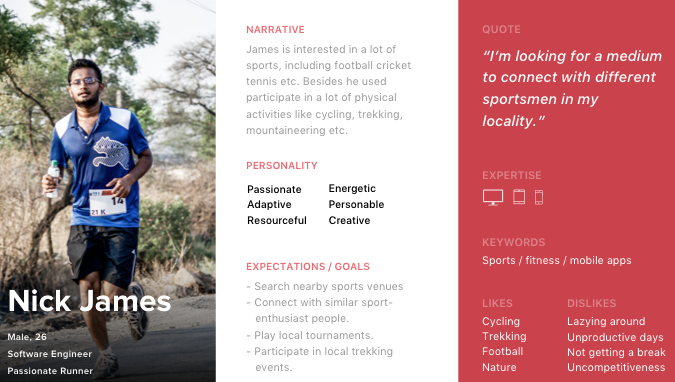At Singletrack Bookkeeping, our ideal customers are “mountain people” (a concept, an attitude – not necessarily a physical location): they are positive people, they love fresh air and the great outdoors, they work hard and then go play harder. They are driven and want to be in control of their own future, and maybe we’re a little weird…and definitely want it all. Lifestyle Entrepreneurs.
It is so important for small business owners to identify customers they want to work with, who they are speaking to, who they are building their product or service for, and what message they are sending to their audience.
In our last blog post, 5 Marketing Strategies to Kick Start Growth, we touched on customer personas. Customer personas are a way to define your ideal customer. Keep in mind, not every business will have the same criteria when defining their ideal customer. If you provide a service, you may take into account the characteristics of the type of person you are working with. If you are selling a product, it becomes more important to focus on demographics such as age, gender, income level, and spending habits. The key component is that this ideal customer is someone you want to work with and/or sell to. This customer is high spending, loyal, and will refer you to their network.

How do you go about collecting this information? Here are a few examples. *Note: this will vary between businesses.
1- Keyword research
What are customer’s typing in to find your brand? For example, let’s say you have a food product. Are they typing [brand name] organic? This would indicate that this person values organic food over other factors such as price. This would fulfill the ‘motivation’ part of a persona.
2- Social Media Insights
Social media analytics already have behavior tied into insights. With Facebook ads for example, you can run several tests to see what resonates with different audiences. You can run tests to see which photos, messaging, and landing pages are resonating. In a recent study, we found that a video from the founder of the company produced a 3x conversion rate compared with static images of their products. We realized the audience valued authenticity which filled the ‘influences’ section of the customer persona.
3- Talk to real people
Start talking to real people who might fit your customer personas. Ask them questions about their pain points, motivations, buying behavior, and who influences them.
4- Perform small tests
As an entrepreneur you will encounter failure. It is inevitable. One way to minimize risk is to perform small tests and fail fast. Take failure as a learning experience and know that you are that much closer to finding your ideal customer. Learn, grow, and evolve.
Get into action!
Grab a beverage, drawing paper and something to write with. It’s time to have fun building your customer avatars. Give them a name, photo, and back story. The more detail you can give this ideal person, the more powerful your decision making will be later.

Photo Credit: Himangshu Borah
Now that you have built your customer personas, it’s time to get strategic. Here a few examples:
1- Create clever content related to your personas. If you’re ideal customer is an environmentally conscious millennial with kids, remind them that your hotel has a kid-friendly pool, poolside bar, and cocktails with 100% compostable straws.
2- Market where your customers spend most of their time. By now you have done the research, collected data, and talked to people to understand which marketing channel resonates with them. Focus on THAT. Iterate quickly and double down on what’s working.
3- Partner with influencers your ideal customer personas value. This doesn’t mean you have to strike a deal with Kilee Jenner tomorrow. There are lots of micro-influencers that are happy to partner with brands for little money or product trades. This is a quick way to build trust with a new segment by attaching yourself to similar interests and values.There are also bigger companies such as 1% for the planet you can partner with by giving away 1% of total sales back to environmental philanthropy causes. If your customer values the environment, this is a way to show them your commitment to their values.
Don’t forget – Always. Be. Testing. Just because you have made customer personas does not mean they wont change along the life cycle of your business. People evolve, companies evolve. Make sure your message evolves with it. The wrong customer + the wrong business = a lot of time and advertising dollars wasted. This simple exercise is a critical step for a new startup or existing business. It’s a very powerful way to get you closer to your customer. Once you identify your ideal customer you can set a true north for business decisions.
You Might Like…
The Multiple Benefits of Hiring A Virtual Assistant
We have talked a lot about niching down to level up. This includes figuring out our strengths and weaknesses. When running your own business, you will undoubtedly wear multiple hats and take on tasks [...]
How Small Businesses Can Compete With Big Brands
Recent news has been calling out big tech such as Facebook for it’s ethical choices in the face of a whistleblower who ousted the company for repeatedly choosing profit over people and buying out [...]
Disaster Prep Your Business
Fires, floods, hurricanes, earthquakes, and extreme weather are threats we are experiencing more regularly due to climate change. This is getting close to home. We have been watching the Caldor fire ravage through California [...]
Celebrate the Wins!
We constantly talk about how businesses and entrepreneurs can be better. This includes how to run your business better, how to run your accounting better, how to have more motivation, and more. We rarely [...]
The Startup End Game
The hardest part about starting a business is starting. We have talked a lot about how to make the leap into entrepreneurship but we rarely talk about the end game. If you haven't also [...]
How Biden’s Proposed Tax Bill Will Affect Small Businesses
The new presidential administration has proposed a large new tax bill to offset other priorities such as improving infrastructure, funding the American Rescue Plan, combating employment inequality and tackling climate change. These are expected [...]







